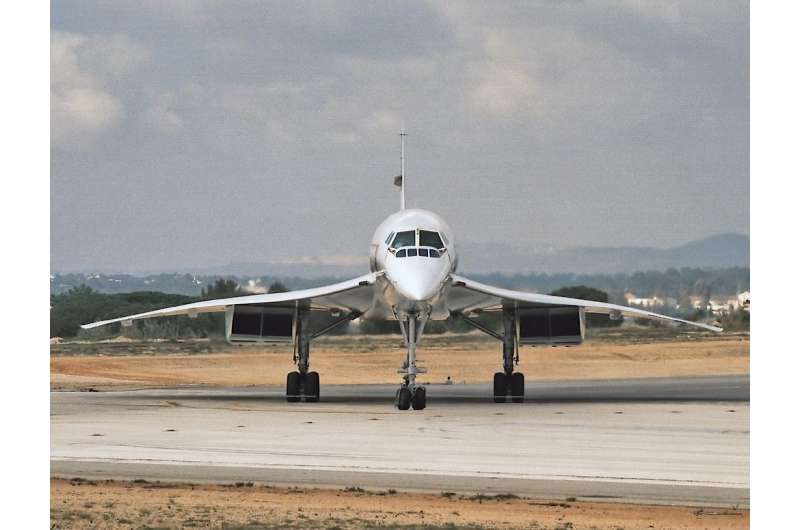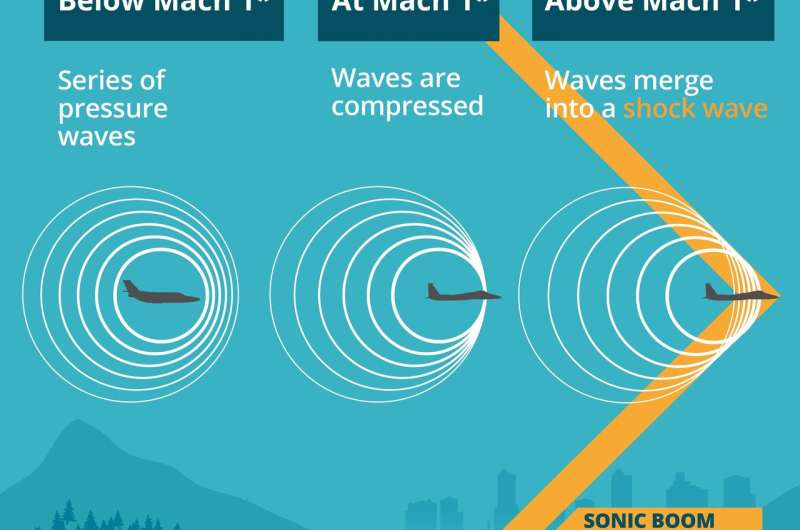Back with a boom? Supersonic planes get ready for a quieter, greener comeback

Almost 20 years after Concorde was grounded, civilian supersonic aircraft seem ready to take off again. New technology is pushing a new generation of aircraft forward, but challenges remain, from regulations to plain old economics.
24 October 2003 was the end of an era. On that day Concorde, the legendary supersonic airliner, made its final commercial flight, flying from London Heathrow to New York City's John F. Kennedy airport. Since then no commercial supersonic airliners have operated—the regulatory, technological and commercial problems being too much to overcome. The futuristic dream of a three-hour flight between London and New York, that Concorde offered, seemed shattered.
Now, however, almost 20 years later, we might be returning to that supersonic dream. New technological advances allow designs to succeed where Concorde failed and a range of companies and research institutes are heavily investing in a new generation of civilian supersonic aircraft. The US company Boom wants to fly a scale model of its supersonic airliner, called the Overture, in 2021, and has already raised $196 million to do it. NASA has pioneered the X-59, an experimental supersonic aircraft that lowers noise levels of the infamous sonic boom. And Aerion, in cooperation with Boeing, is developing a supersonic business jet, which could fly by 2025.
"This is not just a dream anymore," said Professor Nicole Viola of the Polytechnic University of Torino in Italy, where she works on supersonic airliners. "Everywhere people are working on this."
Sonic boom
One important boost behind the resurgence of civilian supersonic aircraft is that they could produce less noise and reduce the problem of a sonic boom.
When an immobile object, such as a stereo, produces sound, its sound waves spread in all directions. If they were visible to the naked eye, these waves would look similar to what happens when a stone is dropped in a pond, with little waves spreading in concentric circles.
When an aeroplane goes supersonic, however, it moves ahead of the sound it produces. This leads to its soundwaves trailing behind the aircraft in a cone-like shape, similar to the waves trailing behind a boat. An approaching supersonic aircraft is inaudible, but when it crosses the observer, they get hit by a sudden, boom-like sound of concentrated sound waves that is quite uncomfortable. In some cases these booms can cause damage to buildings and supersonic military jets flying over land have even been known to break windows.
This means that in most countries, routine supersonic flight is banned over land, severely limiting the potential routes of a civilian supersonic plane. For this reason, Concorde only flew routes that were largely over water.
New designs, however, are pioneering so-called low-boom technology.
"The (intensity) of the sonic boom is mainly dependent on the aerodynamic shape of the plane," explained Gérald Carrier, senior aerodynamicist at French aerospace lab ONERA. He was involved in a project called RUMBLE, which gathered evidence around the noise emitted by sonic booms and low-boom aircraft for regulatory authorities.
Carrier notes that, by shaping the geometry of the plane, the loudness of the boom can be reduced from more than 100 decibels for Concorde, similar to listening to a jackhammer, to 70-80 decibels for the new designs, about the sound of a vacuum cleaner.
"Proper shaping of the aircraft with characteristics like a very long front nose can reduce noise. By mastering this we can sculpt the sound signature of the aircraft and make the boom less annoying."
For now, low-boom civilian aircraft are still theoretical, although they're getting closer to launch. Boom hopes to fly a one-third scale model of their design in 2021 and NASA wants to start flight tests of the X-59 in 2022. Carrier compares the noise new low-boom designs would make to very distant fireworks. People would still hear it, but it's not window-breaking loud.
Low-boom became possible because of advances in tools and research. New computers programs make it easier to simulate the properties of an aircraft and experiment with 3-D-shapes. And since the 1960s, when Concorde was designed, we know much more about sonic booms. "We benefit from decades of new research and developments," said Carrier.
Yet even this new generation of supersonic aircraft will still produce noise, and regulation needs to be crafted for these low-boom designs. The RUMBLE project simulated how much sound these new aircraft would produce and what the effect would be on buildings, measured sonic booms with Russian military aircraft and even studied the effect on humans.

"We looked at how people reacted to different levels of sonic booms, so called psycho-acoustic studies," said Carrier. Specifically, they put speakers next to a house in which test subjects were located. From time to time these speakers produced sounds similar to a sonic boom. The test subjects then had to report how this affected their wellbeing, capacity to do tasks and ability to sleep. Based on these results, governments can decide how much noise is acceptable from these new aircraft.
"We want to help define regulations that can limit the sonic boom of new aircraft to an acceptable level for humans," said Carrier. These regulations might then allow supersonic aircraft to fly over land, dramatically expanding the routes they can service.
Mach
In Torino, Prof. Viola will be exploring another way to test sonic boom in her project MOREandLESS, which has just kicked off and will run for four years. In one experiment, researchers will shoot small projectiles in the shape of planes out of a gun on a large, outdoor testing track. The projectiles achieve a sonic boom, which is then measured by microphones situated around the track to see what different designs will do for the noise. "We will investigate a wide range of speeds, from Mach 2 to 5," said Prof. Viola.
Mach is the unit of speed for supersonic aircraft. Mach 1 means that the aircraft goes as fast as the speed of sound at that location, which can differ based on the local temperature, which, in turn, is mainly dependent on altitude (the higher up in the atmosphere, the lower temperatures are). At sea level, with a temperature of 15°C, Mach 1 is located at 340.3 metres per second or 1225.08 km per hour. At an altitude of 11,000 metres, that becomes 295 metres per second or 1062 km per hour. Supersonic is generally designated as the area between Mach 1 and 5, or 1 to 5 times the speed of sound. The Boom Overture, for example, is planned to maintain a Mach 2.2 speed, similar to the cruising speed of Concorde.
Prof. Viola is also studying fuel options—another key issue that new supersonic civilian aircraft will face. One of the reasons why Concorde was uneconomical was its high fuel consumption, especially during low-speed phases of flight. And although the new generation of supersonic aircraft designs have reduced fuel use through interventions like more economical engines and better aerodynamics, they would still spend more than a regular, subsonic jet, producing problems of pollution and climate impact.
A key way to reduce this is new forms of fuel. "Emissions of course depend on the type of engine," said Prof. Viola. "But they also depend on the fuel, and the chemical processes at the basis of combustion."
For Prof. Viola, two candidates for more sustainable fuels spring out: biofuels and liquid hydrogen. Hydrogen is 'candidate number 1," said Prof. Viola, because it doesn't produce CO2 emissions. But biofuels, which are derived from biomass such as plants or waste, are also still in the running, possibly mixed in with regular jet fuel.
Economics
But for all the new technology, what will make or break the new generation of supersonic is economics. "The last straw for Concorde was that the economics just weren't viable," said Dr. Turab Zaidi, who jointly leads the Aerospace Systems Design Lab at Georgia Tech Lorraine, which is located in Metz, France. "British Airways and Air France just couldn't stand the amount of money they were losing."
Dr. Zaidi investigated whether that situation will shift in the future for the project OASyS, and whether airlines can profitably operate these new aircraft. In the project they developed two scenarios for supersonic airliners in the period between 2035 and 2050, and their conclusion seems cautiously optimistic.
"Across the scenarios we found that a market does exist," said Dr. Zaidi. "It's not as high as some of the manufacturers are projecting. But granting certain assumptions, there is a market."
Their study starts from the current aviation market and projects how it will evolve, taking into account economic growth, which will most likely produce an increase in the use of airlines. It then calculates the size of the group of consumers who would take these supersonic aircraft, such as business passengers wanting fast connections or tourists who now pay for the premium offerings of airlines.
However, this potential market relies on a range of assumptions on how supersonic aircraft will evolve, such as fuel efficiency and regulation.
"For the high-demand scenario, we assumed land overflight is permitted," said Dr. Zaidi. "That is one of the big constraints on a high-demand scenario. When you don't allow land overflight, you severely limit the amount of destinations and force planes to fly slower when over land, reducing fuel efficiency."
Nevertheless, in general, Dr. Zaidi seems optimistic. "A lot of the things that ended Concorde have shifted," he said. "The demand for fast airline connections never went away since then and we might see a resurgence now."




















